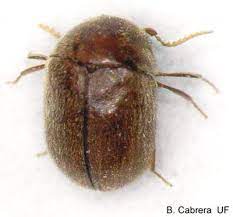How do I get rid of cigarette beetles?

cigarette beetle
The first step in cigarette beetle control in houses is a careful inspection. Finding all infected objects is crucial since these beetles can consume a wide range of products. Throw away any contaminated food.
Examine carefully because these beetles can infest a wide range of products. There could be a number of infected products.
All pantries and cabinets where food is kept should have their shelves cleaned using a vacuum.
Food residue can be removed by vacuuming.
New food products should be kept in airtight glass or plastic containers.
The last stage is the application of insecticide.
Use it in cracks and crevices, including those under baseboards and behind pantry shelves.
The goal is to get rid of adult beetles that have left the afflicted materials and spread out.
Appearance
The cigarette beetle, Lasiodermaserricorne (Fabricius), gets its name from attacking stored tobacco. It is a stored product pest throughout the world.
Size: The adult beetle is a small insect (2 to 3 mm).
Color: It is usually light brown.
Head: The head is bent down and barely visible from above. This gives the beetle a rounded or “humped” appearance.
Behavior
Due to its predation on tobacco storage, the cigarette beetle earned its name. Pest of stored goods everywhere throughout the planet.
The adult beetles can fly well. When the light is dim, they become quite active.On cloudy days and in the late afternoon, they fly easily. When disturbed, cigarette beetles “play dead” for a short while.
Reproduction & Life Cycle
The food material is where the female beetle deposits her eggs.
These beetles infest a wide range of goods, such as pasta, wheat, cereal, and pet food.
Books, dried flowers, spices, leather, silk, old rat bait, and even museum specimens have all been infected.
Spices and dry pet food are two staple feeds for cigarette beetles in households.
Larvae consume food to grow.
As the time comes for them to become adults, they spin a cocoon.
From egg to reproducing adult, the full life cycle spans 30 to 90 days.
In lower temperatures, development slows and eventually stops below 65°F.